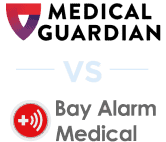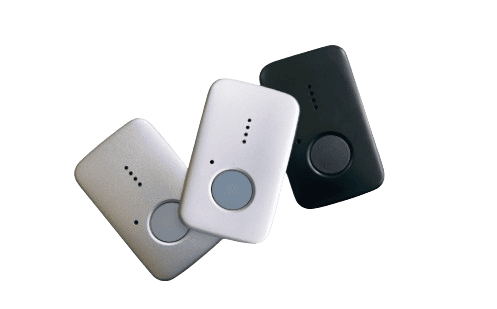
MGMini Medical Alert Review, Tested by Caregivers


Medical alert systems are infamously clunky, large wearables. And in my experience, most older adults are unwilling to wear them, making the devices useless. However, in recent years, many companies have introduced medical alert systems that are more streamlined and discreet.
Roughly 2 inches tall and 1 inch wide, the MGMini is one of the smallest devices that we’ve tested. Despite its small size, this mobile medical alert packs in a speakerphone, help button, 4G cellular connection, and fall detection. If your loved one has been put off by larger and more cumbersome devices, then the MGMini might be a match.
When I tested the MGMini both inside and outside my home for a week, it excelled in most areas. Its response times were fast, its GPS was accurate, and its caregiver app is among the more sophisticated such apps on the market. Provided fall detection is not your top priority (more on that below), the MGMini is a great option for a mobile medical alert system.
Key Findings
- The MGMini stands out with an impressively fast eight-second average response time and ultracompact size that makes it comfortable for all-day wear.
- Despite its strengths, the MGMini’s fall-detection capability was disappointing: It detected only one out of 10 test falls, making it unsuitable for users who prioritize this feature.
- While more expensive than some competitors — at $149.95 plus $39.95 monthly — the MGMini offers advanced caregiver monitoring through the MyGuardian app for no extra charge.
FYI: The MGMini performed well, but it’s far from the most affordable medical alert system. To find devices from $25 per month, read our guide to the best medical alert systems.
Why Trust Us?
Our team of caregivers, experts, and health care professionals conducted over 5,000 hours of in-depth research and testing. The results helped us recommend the most reliable brands and devices. In this process, our team:
- Tested 50 medical alert devices from 15 different brands.
- Surveyed 1,250 seniors and caregivers on medical alert system usage.
- Consulted with nurses, EMTs, and caregivers who are experts at caring for older adults.
- Published dozens of videos that demonstrate our medical alert system testing.
- Evaluated verified customer reviews of medical alert companies from the Better Business Bureau.
- Continues to monitor developments in the world of medical alert systems and revises our findings accordingly.
How We Tested the MGMini
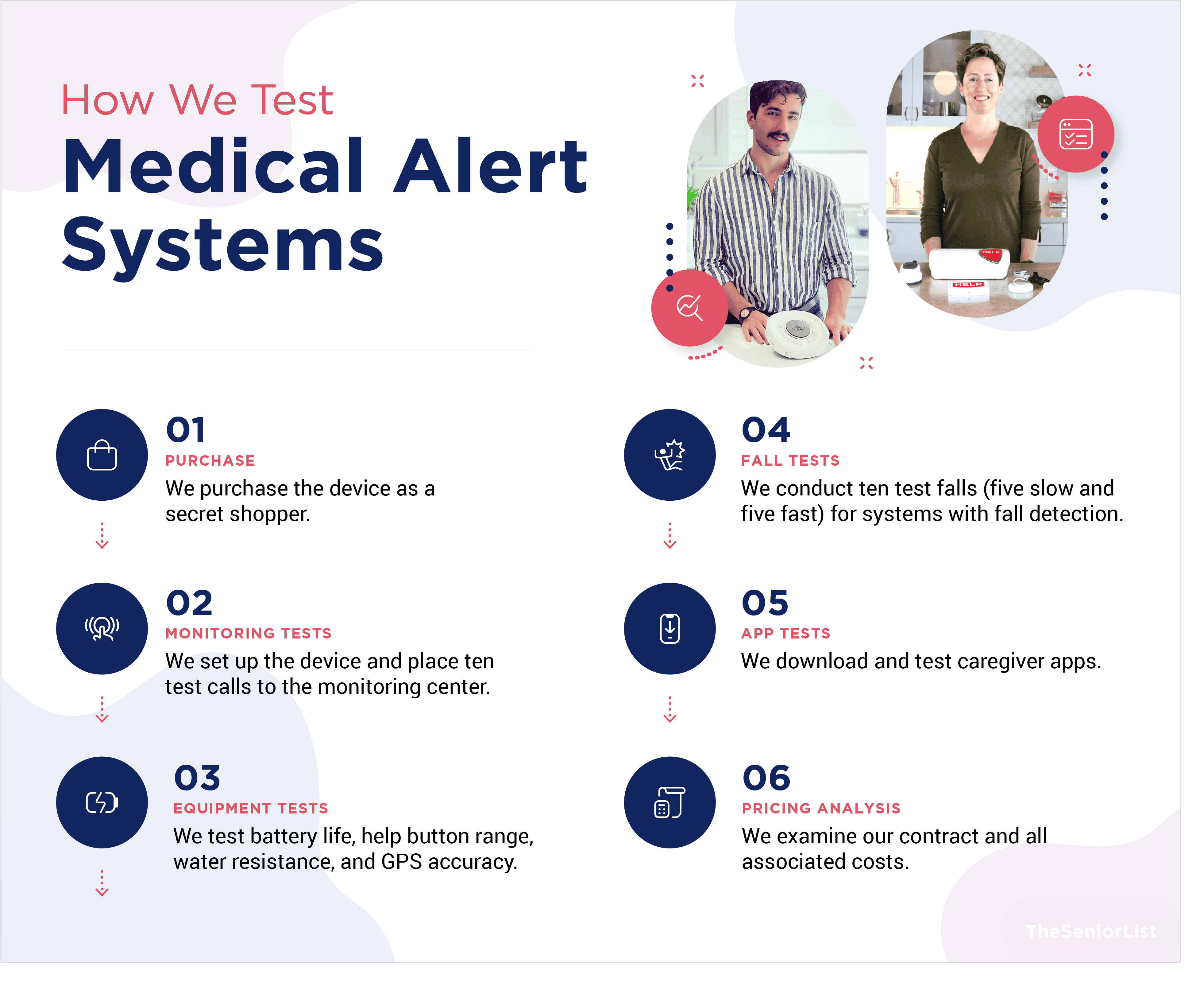
While Medical Guardian has multiple systems (read our Medical Guardian review to learn more), this review will focus on the MGMini. Here is how we evaluated this mobile system:
- Response times: We placed 10 test calls with the MGMini and calculated the average response time.
- Ease of use: Through testing and design analysis, we ensured that the device was easy to use, particularly for those with visual impairments and manual dexterity issues.
- Customer care: We conducted extensive interactions with Medical Guardian’s customer care teams and monitoring agents, ensuring they offered adequate support.
- Affordable pricing: We examined the costs of the MGMini and compared them to similar systems from other companies.
- Flexible contracts: We read the fine print of our Medical Guardian service agreement, ensuring there were no unexpected fees or obligations.
- Extra features: Apart from conducting test calls, we also tested the MGMini fall detection, water-resistance, in-home range, GPS, and caregiver connectivity features.
MGMini Pros and Cons

MGMini Pros
- Fast response time: Averaging eight seconds in my 10 test calls, the MGMini lives up to Medical Guardian’s lightning-fast response times.
- Caregiver connectivity: The MyGuardian app allows loved ones to track my device’s location and be notified when I make emergency calls.
- Water-resistant: The MGMini is water-resistant, meaning you can wear it in the shower without damaging it. This is an essential feature, as studies have found that bathroom falls are more likely to be injurious.
- Four-day battery life: The MGMini lasted four days before I needed to recharge it. This is pretty long for a mobile medical alert system.
MGMini Cons
- Poor fall detection: Of my 10 test falls, the MGMini detected only one. To find a more reliable fall detection device, read my guide to the best fall detection devices.
- Higher costs: The MGMini device costs $149.95, and monthly monitoring fees are $39.95 ($49.95 with fall detection). For more affordable options, read my rundown of the most affordable medical alert systems.
MGMini Specs
| Size | 2.15 x 1.3 x 0.57 inches |
| Weight | 1.28 ounces |
| Average Response Time | 8 seconds |
| Battery Life | 4 days |
| Water-Resistance | IP67 (water-resistant) |
| Cellular Signal | 4G LTE |
| Starting Monthly Price | $39.95 |
MGMini vs. MGMini Lite
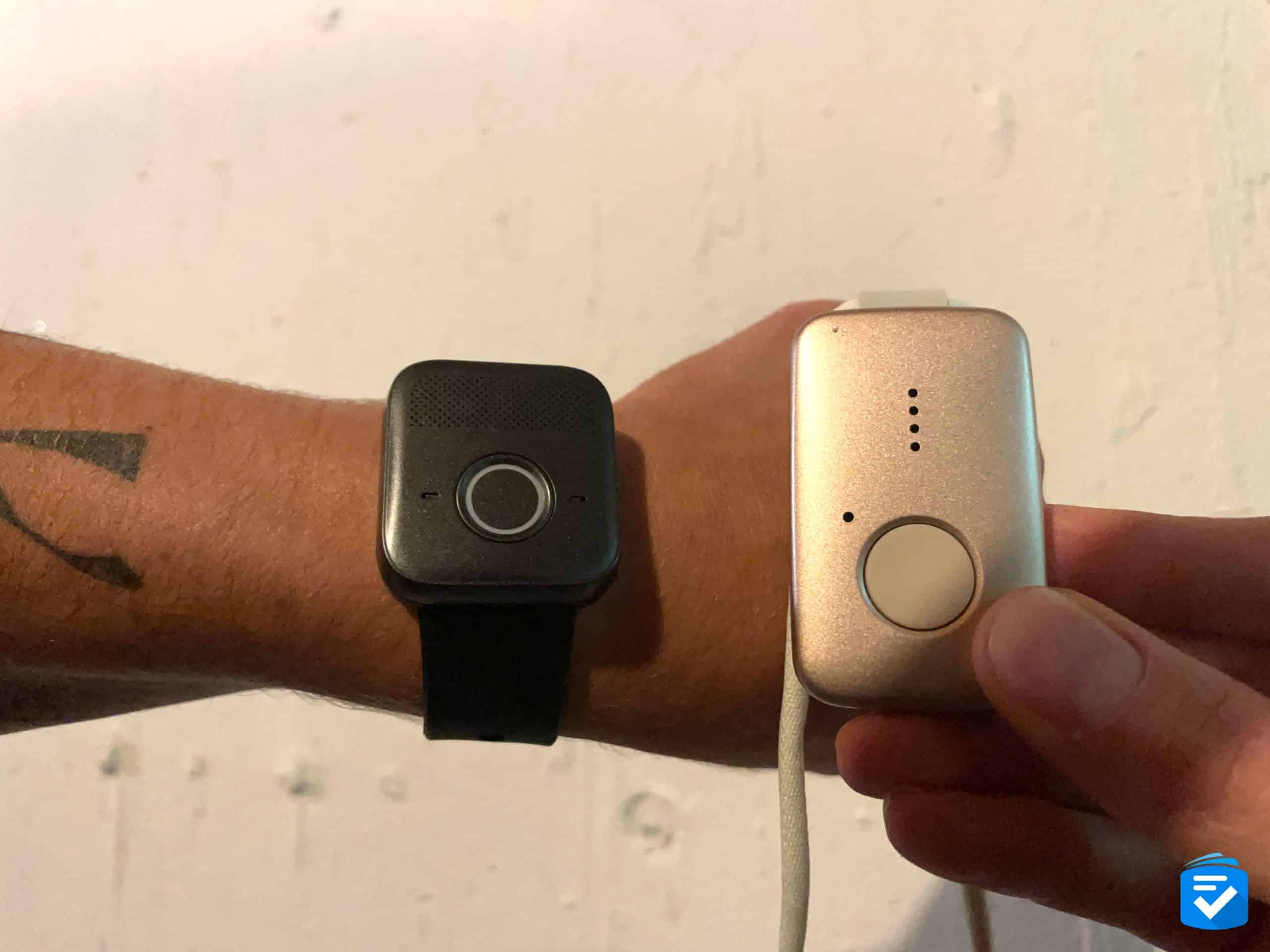
If you’re pursuing the Medical Guardian website, you may have noticed a similar device to the MGMini: the MGMini Lite. This is essentially a bracelet version of the MGMini pendant. It costs the same for the equipment ($149.95), but the monthly costs are a bit higher with the MGMini Lite: $46.95 versus $39.95.
Both mobile systems use the same app and have the same fast response times. However, in my tests, I noticed one major difference: The MGMini Lite had much more accurate fall detection. It detected eight out of my 10 test falls; the MGMini only detected one.
I recommend the MGMini Lite if you’d rather wear a medical alert bracelet or if fall detection is a desired feature. Otherwise, go with the MGMini to save a few bucks each month. To learn more, read my MGMini Lite review.
| MGMini | MGMini Lite | |
|---|---|---|
| Form Factor | Pendant | Bracelet |
| Equipment Cost | $149.95 | $149.95 |
| Monthly Cost | $39.95 | $46.95 |
| Monthly Cost With Fall Detection | $49.95 | $56.95 |
| Fall Detection Performance | Poor (1/10 test falls detected) | Good (8/10 test falls detected) |
| Battery Life | 4 days | 36 hours |
| Water Resistance | IP67 (shower-safe) | IP67 (shower-safe) |
| Cellular Network | 4G LTE | 4G LTE |
| GPS Tracking | Yes | Yes |
MGMini Video Review
Want to see me placing a series of test calls with the MGMini? Then watch our full video review.
My Experience With the MGMini
Unboxing
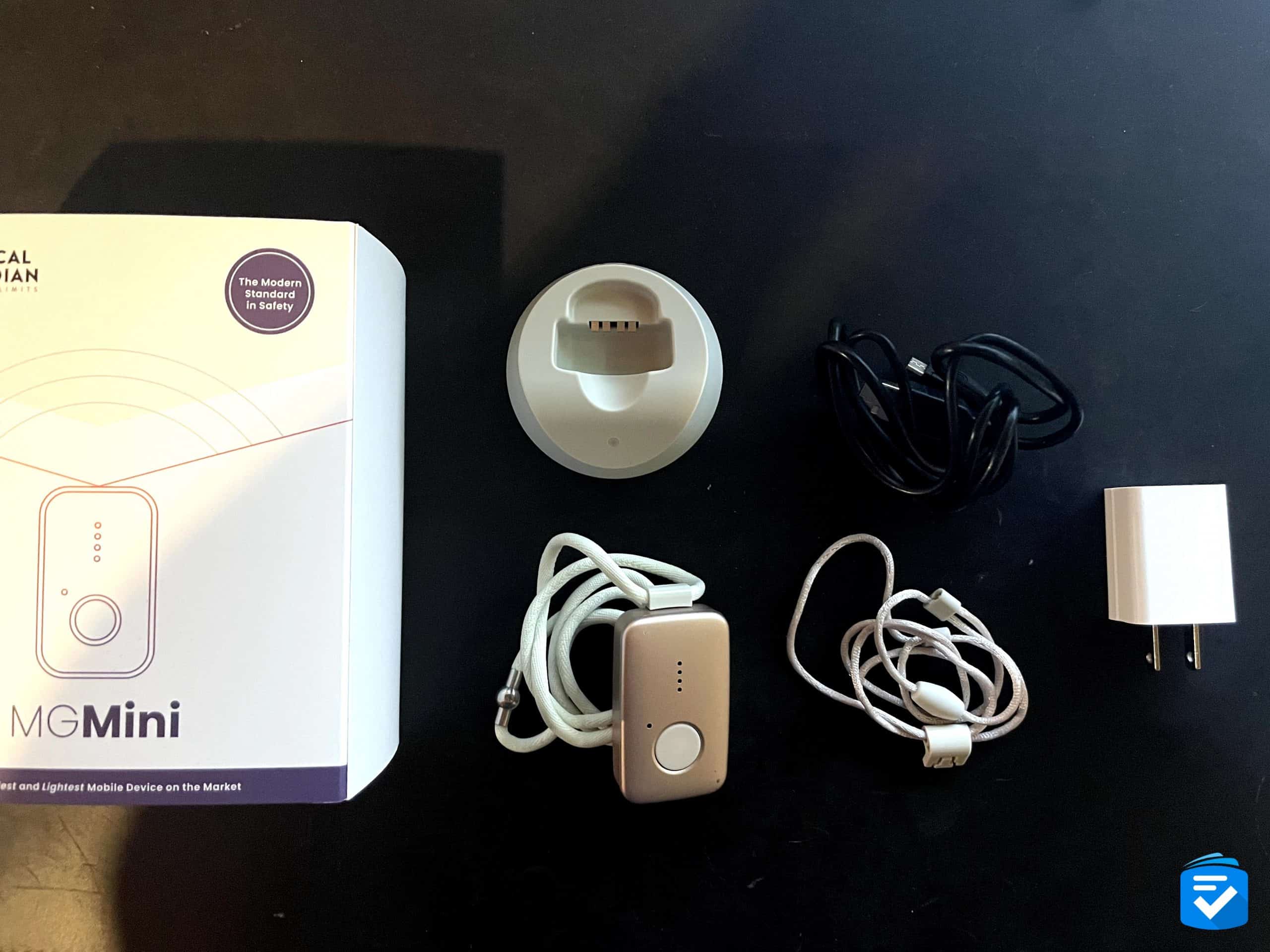
My MGMini purchase included the following:
- MGMini device
- One nonadjustable lanyard
- One belt clip
- One adjustable lanyard
- One charging cradle
- One charging brick
- One USB charging cable
Activation
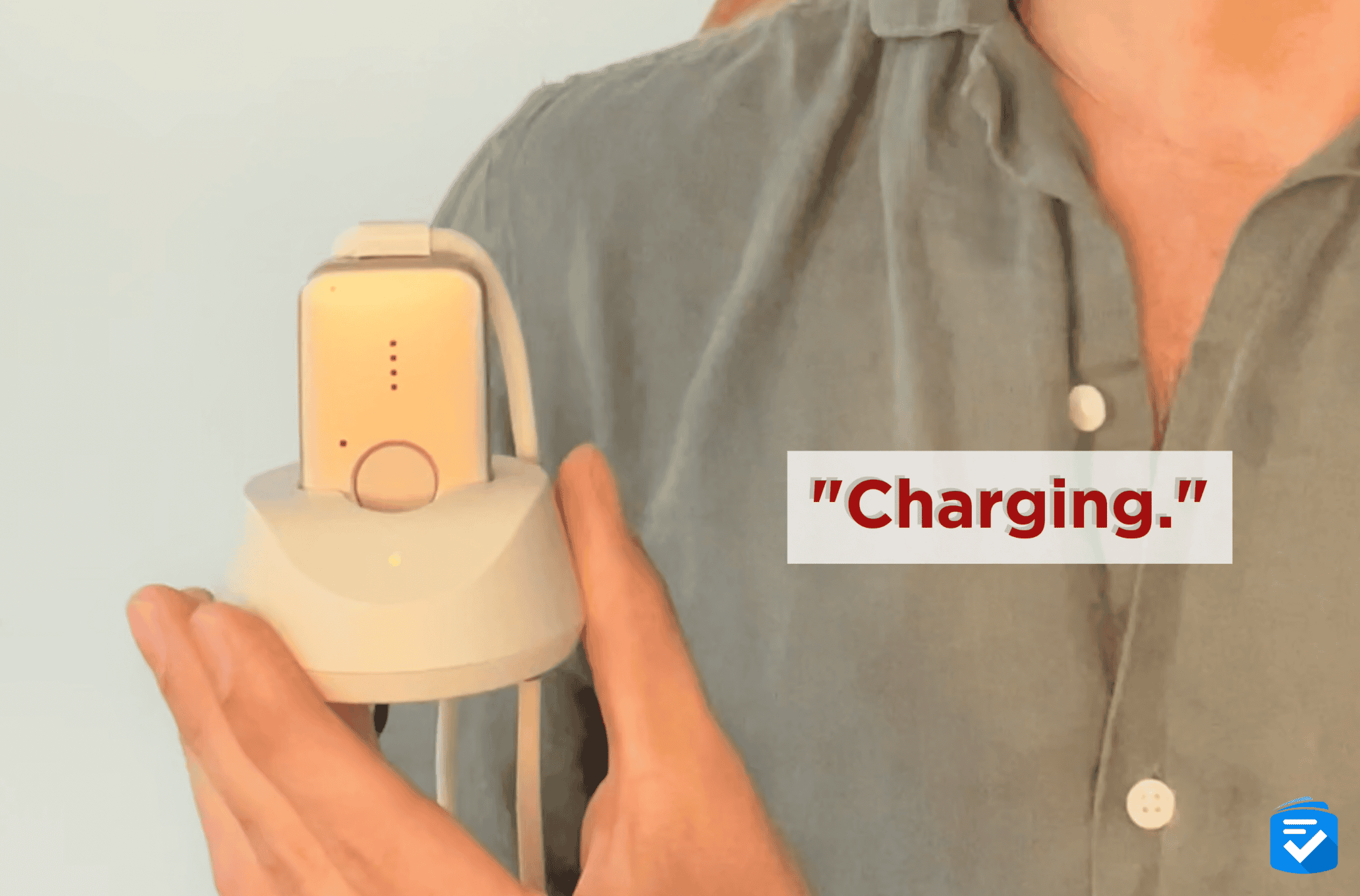
To get started, I plugged one end of my USB wire into the charging brick and the other into the charging cradle, then plugged it into my wall. The charging cradle displayed a green light, and I put the MGMini on my charger with the help button facing toward me. The device said it was powering on and then charging. Once the LED light turned from red to green — about four hours later — it was fully charged and said, “Device ready.”
The good news is that there wasn’t an activation fee on top of what I already paid for the equipment and subscription. This is a win over the Lively Mobile2, which charges an activation fee of $35 (although you can save $10 by activating online). No activation fees are fine by me, as I paid enough money upfront for the MGMini.
Performance
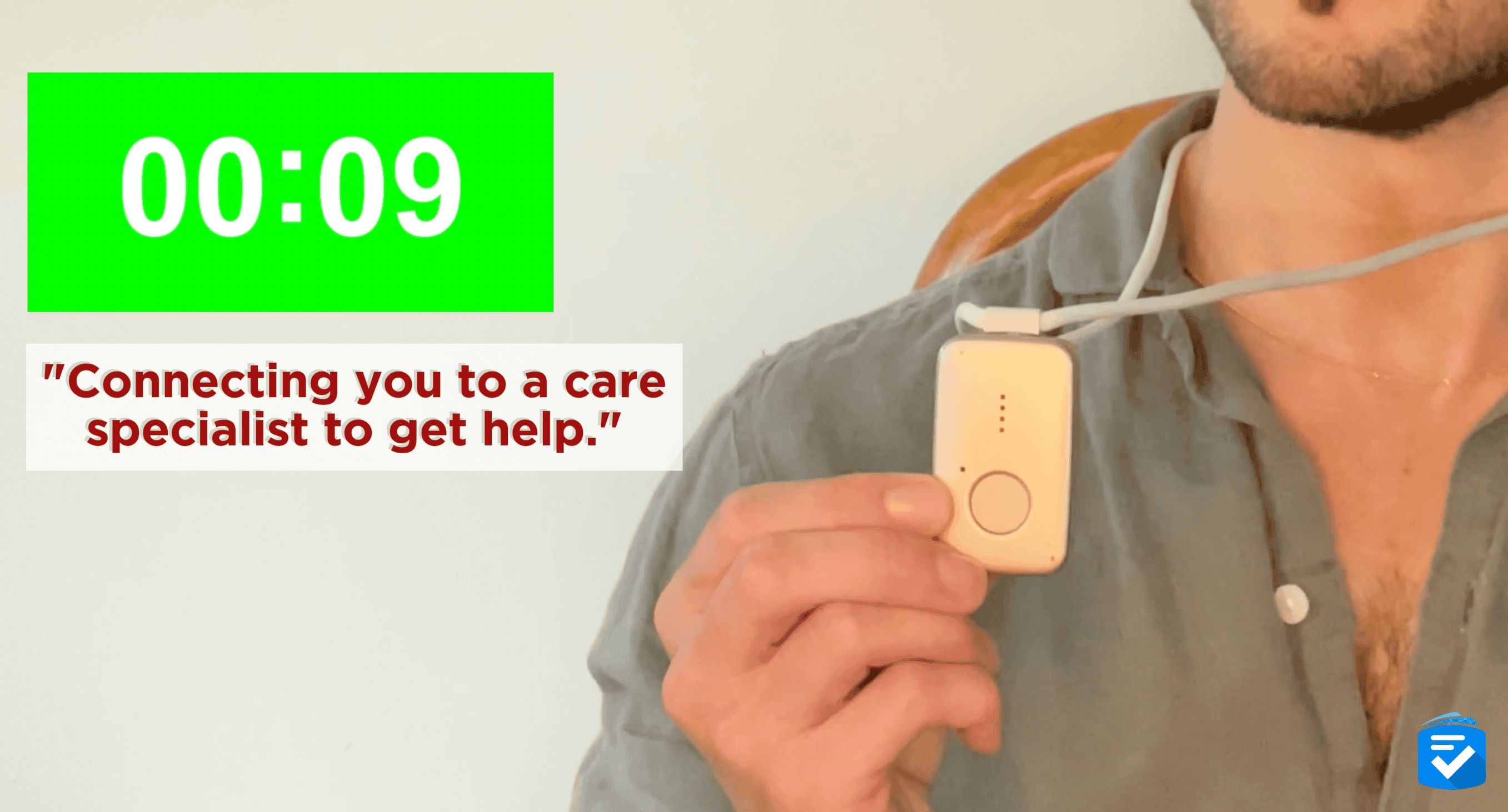
Once the device was ready, I tested it to ensure it was working correctly. To do this, I pressed the side button twice; the device then told me to press the help button to get to the test center. I pressed the help button for two seconds, and it asked me to say my name to the microphone. The test went smoothly, and the device told me when it was complete. With a loud speaker and easy voice activation, the MGMini is one of the best medical alert systems for users with hearing loss.
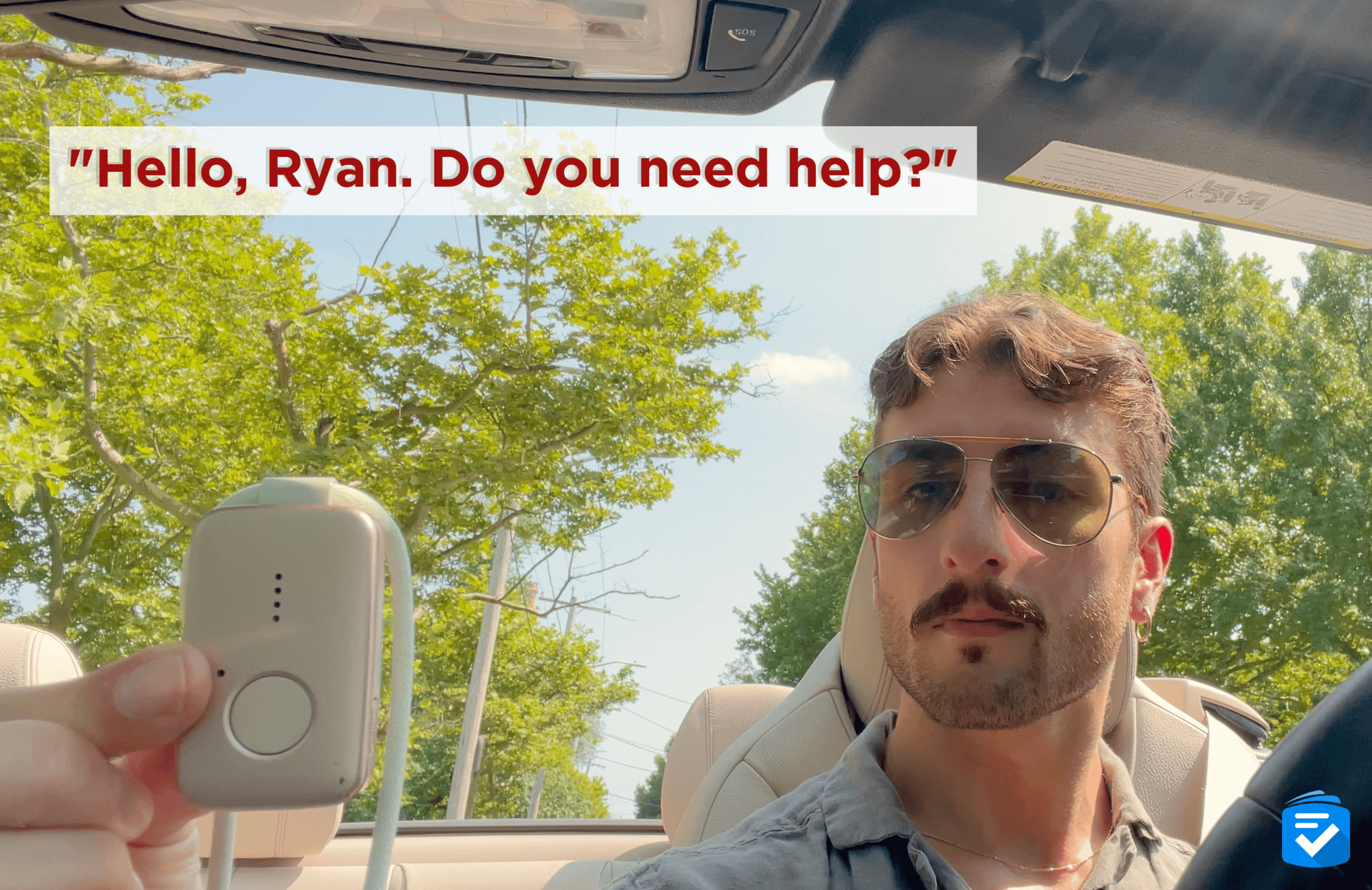
Using the MGMini throughout my testing period provided consistent peace of mind wherever I went. The reliable performance was evident whether I was completing household chores or running errands outside. The device’s water-resistant design meant this protection extended even to shower time, when bathroom falls are particularly concerning. Perhaps most impressive was the lightweight design. The MGMini was so comfortable that I frequently forgot I was wearing it at all, which solves one of the biggest problems with medical alert devices that often go unused: They feel burdensome to wear.

In my 10 test falls with the MGMini, it detected zero slow falls and one fast fall. This was disappointing, seeing as every other feature of the device worked well. According to the Agency for Healthcare Research and Quality, a prompt response after a fall can significantly reduce complications and hospitalization time, making reliable fall detection a crucial feature of a medical alert device. So if fall detection is an important feature for you, I’d recommend the MGMini Lite.
MyMedicalGuardian App
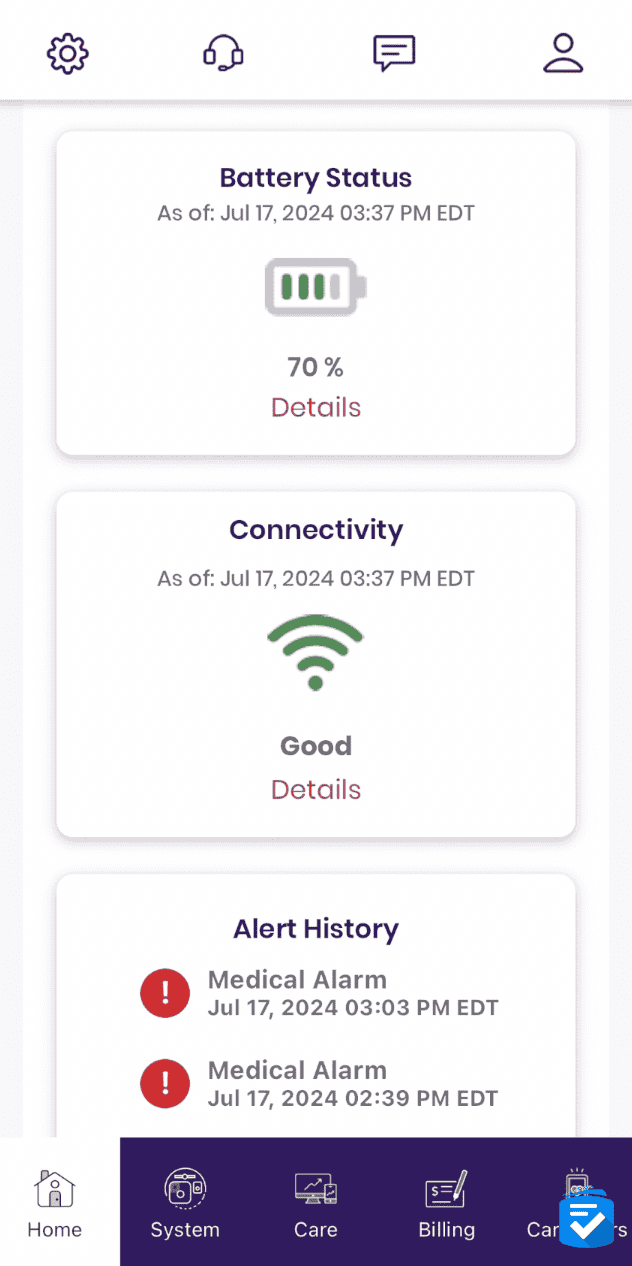
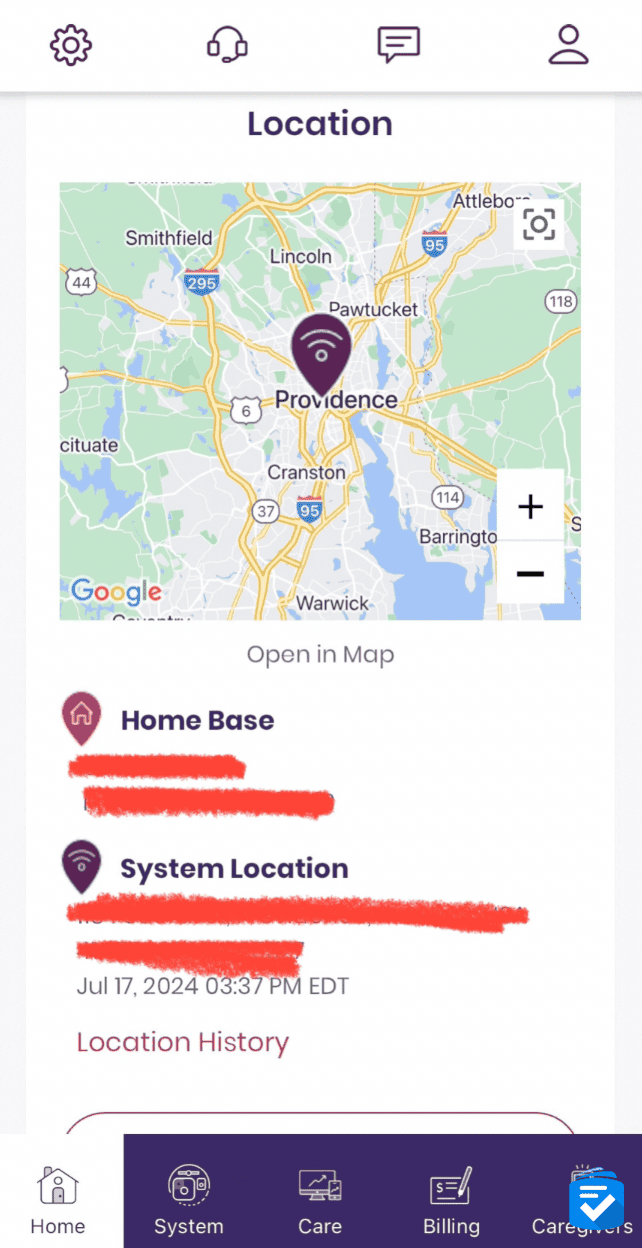
As with other Medical Guardian systems, the MGMini includes access to the MyGuardian portal. Through MyGuardian — available via an internet browser or smartphone app — loved ones can remotely monitor the device.
These connectivity features are particularly valuable given that social isolation can increase health risks for seniors that are comparable to smoking 15 cigarettes daily, according to research published in The Journals of Gerontology. The ability for family members to stay connected through the app provides both practical safety and emotional reassurance.
From his smartphone, my partner could track my location and check the battery life of my device. He could also ensure that it had an adequate cellular signal and check on my alert history. The one noteworthy omission here is push notifications.
While the MyGuardian portal allows you to view a history of emergency calls, it will not automatically notify loved ones when the call is made. To activate this feature (Medical Guardian’s OnGuard Alerts), you’ll have to pay an extra $2.99 per month. Once enabled, loved ones will receive text messages when the MGMini places an emergency call. While I appreciate this feature, I did not appreciate the extra charge, especially when companies like Lively and Bay Alarm Medical include it for free.
MGMini Pricing
The MGMini costs a one-time $149.95 for the device, followed by monthly payments of $39.95. Fall detection costs an extra $10 per month (not that I’d recommend it here), and OnGuard text alerts cost an extra $2.99 per month. Medical Guardian also offers a variety of optional accessories for this device, including a voice-activated help button and lockbox. Each of these accessories will come with additional monthly charges.
Overall, these prices are a bit higher than average, as is the case with Medical Guardian’s other systems. Additionally, while Medical Guardian doesn’t require long-term contracts, the company does not offer a free trial period to try their devices. When I canceled my service, I only received a prorated refund for my monthly $39.95. The $149.95 device cost is nonrefundable.
For a more affordable mobile device that comes with a 30-day trial period, I’d recommend checking out our Bay Alarm Medical review. To learn more about Medical Guardian’s pricing and refund policy, read my full guide to Medical Guardian costs.
Compare Medical Guardian to Other Brands
My Verdict
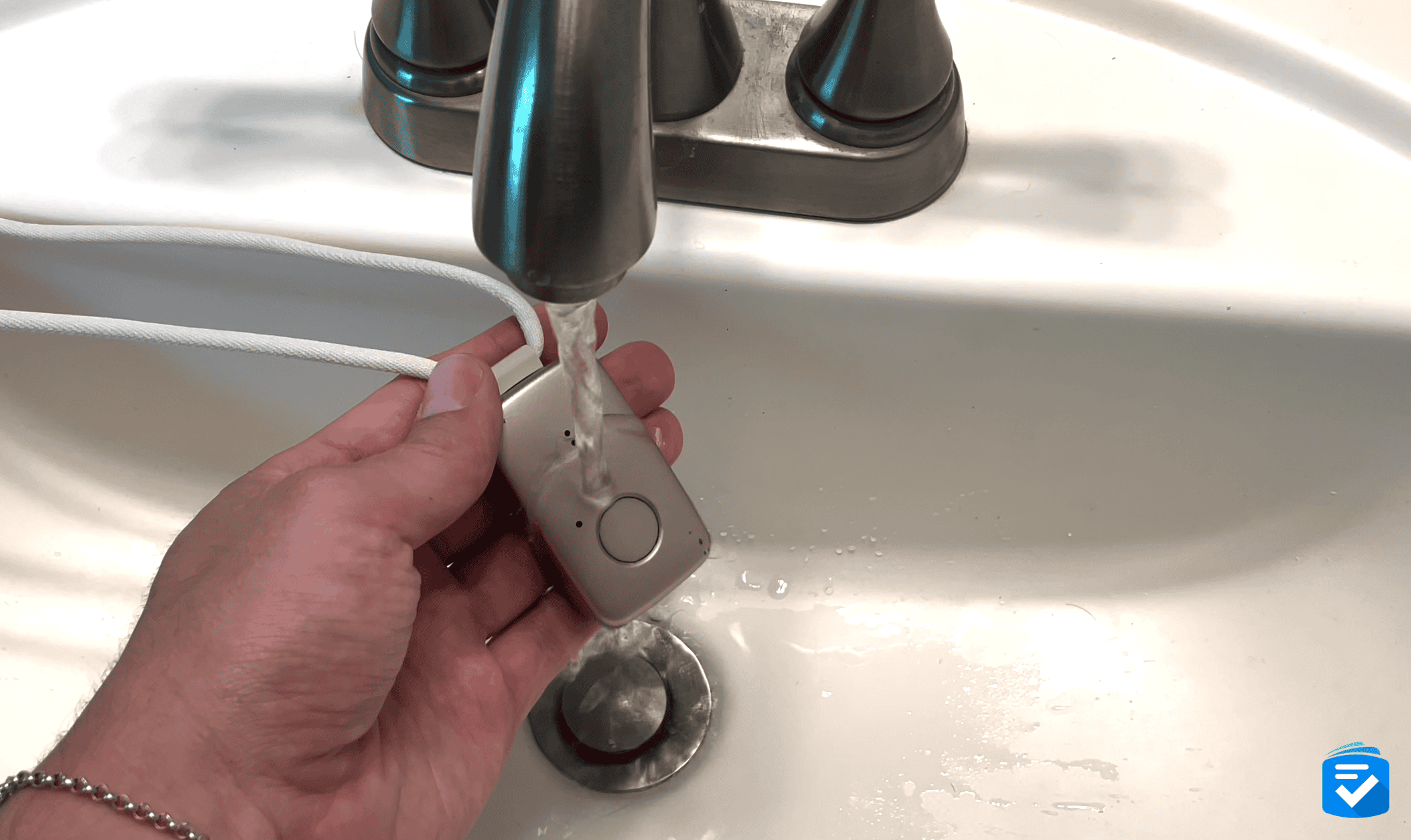
The fall detection was disappointing, and the equipment was priced on the higher side. However, I’d still recommend the MGMini to active seniors who want a comfortable and unobtrusive medical alert system. It’s ideal if you want to use a device for days on end without charging.
However, it’s not a good option if you are seriously worried about falling and want a more dependable fall detection — despite the eight-second response time. It’s also not the cheapest option around, especially with the up-front equipment costs. For more information about other Medical Guardian devices, read my Medical Guardian reviews.
Frequently Asked Questions
-
How long does the MGMini battery last?
The MGMini has an impressive four-day battery life on a single charge, which is considerably longer than many competing mobile medical alert devices. This makes it ideal for active seniors who don’t want to worry about daily charging. The device also clearly indicates when the battery is low through both visual and audio alerts.
-
Is the MGMini waterproof?
The MGMini is water-resistant with an IP67 rating, which means it safely can be worn in the shower but shouldn’t be fully submerged in water for extended periods. This water resistance is crucial for shower safety, as bathrooms are common locations for falls among older adults.
-
Does the MGMini work outside the home?
Yes, the MGMini works anywhere with cellular coverage, as it operates on a nationwide 4G LTE network. This makes it ideal for active seniors who frequently leave their homes. The GPS tracking feature also allows caregivers to locate the user through the MyGuardian app in case of emergency.
-
How accurate is the MGMini's fall detection?
Based on our testing, the MGMini’s fall detection is not very reliable, detecting only one out of 10 test falls. If fall detection is a priority, consider the MGMini Lite bracelet version instead, which detected eight out of 10 falls in our tests.
-
Can family members be notified when the emergency button is pressed?
Yes, but this requires the additional OnGuard Alerts feature, which costs an extra $2.99 per month. Once activated, designated contacts will receive text message notifications when the emergency button is pressed. Without this add-on, caregivers can still view alert history through the MyGuardian app but won’t receive real-time notifications.
-
Is there a contract or cancellation fee for the MGMini?
Medical Guardian doesn’t require long-term contracts for the MGMini, and you can cancel at any time. Upon cancellation, you’ll receive a prorated refund for any unused portion of your monthly subscription ($39.95). However, the one-time equipment fee ($149.95) is nonrefundable, and there is no free trial period.



